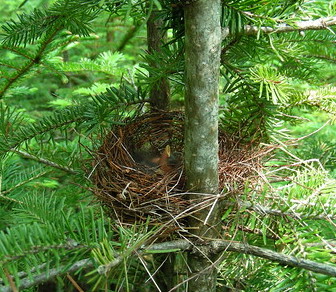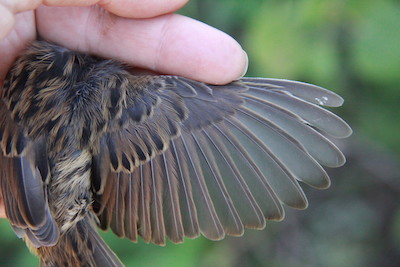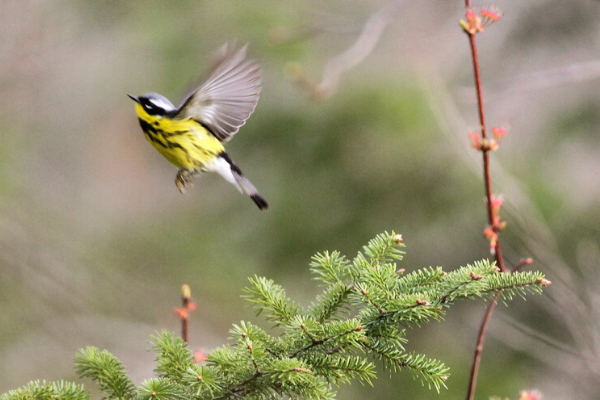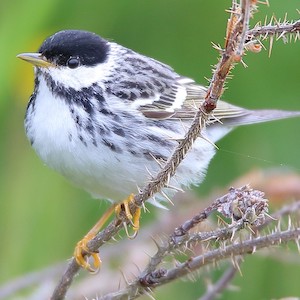The yearling male Magnolia Warbler had been exploring the area for days, trying to find a patch with enough food, cover and good nest sites where he could establish a territory and attract a mate. The patch he had visited yesterday had been adequate but not ideal; the trees weren't tall enough and they were too far apart. But today's patch was perfect. Densely packed with young conifers and a nice bit of upper canopy cover, insects should be abundant and there were plenty of places to hide a nest here. It reminded him of the patch of forest where he had hatched the year before.
He perched on a young spruce and tentatively began to sing. Almost immediately, an older male appeared, seemingly out of nowhere. He circled the yearling menacingly, hopping from branch to branch, flashing the bright white patches in his wings and tail. Then with a series of loud "yeek" calls the older male launched himself at the yearling chasing him out of the conifer stand. The yearling took cover in a bush on the other side of the stream, gathered himself and retraced his path to the sub-par patch he had explored yesterday. It would have to do.

A Magnolia Warbler nest. Photo by Kent McFarland.
This is an imagined scene but it's not far-fetched. In a 2004 study, Sievert Rohwer showed that older Townsend and Hermit Warbler males chased off and excluded yearling males from prime breeding habitat. In a new study in the journal PeerJ, IBP biologist Peter Pyle along with colleagues from both IBP and Owl Moon Environmental Inc., used MAPS bird-banding data to look at which habitats yearlings use in a community of 29 bird species that breed in the boreal forest of Alberta, Canada. This is the first analysis to look at how the probability of capturing yearlings relates to habitat characteristics in a community of landbirds rather than a single, or pair, of species.
But, as is often the case in the scientific process, looking at the relationship between yearlings and habitat was not the original plan for the analyses. "Our original goal for this paper was tolook at yearling proportion from a demographic angle," says Pyle. For instance, the researchers wanted to see how the proportion of yearlings related to things like productivity (the number of young produced) in the year before. You would expect to see high productivity one year in a species correlate to a higher yearling proportion the following year."Being able to find such correlations and model them with other factors could help us calculate juvenile survival (between fledging and first breeding at a year of age), widely thought to be lower than adult survival but extremely difficult to directly measure because, as opposed to adults, fledglings typically do not return to their natal area [birthplace] to breed," says Pyle, "But we found practically no correlations for any of these types of comparisons, overall, or for any of our 29 species! This was surprising to me." The researchers plan to tackle the topic again in the future armed with a few more years of data and improved statistical models.
However, the MAPS dataset presented another interesting opportunity. The MAPS stations in question were located in the oil sands region of northeastern Alberta where some areas of forest had been cleared for oil sands development and later reclaimed (replanted with trees), while others were undisturbed. Data were collected from reclaimed areas ranging from about 1 year since reclamation (tree planting) to about 35 years since reclamation began, as well as undisturbed areas, representing a range of successional stages. This presented an opportunity to look at how reclaimed habitat changed as vegetation matured, and how the habitat age and characteristics related to the proportion of yearling birds captured.
The researchers used habitat data they collected on the ground and acquired from databases created by satellite measurements. NASA has a satellite that measures what is known as the Enhanced Vegetation Index (EVI). EVI is a composite measurement that incorporates components like primary productivity (leaf chlorophyll content), leaf area, canopy cover and vegetation complexity. The habitat data showed that mid-story forest cover develops within the first 30 years after reclamation or replanting, but that the tall forest canopy doesn't really start to develop until more than 30 years after reclamation. Comparisons of EVI, collected by satellite, and data collected on the ground showed that EVI can adequately track habitat characteristics for about 20-30 years following reclamation in the boreal forest. However once a full forest canopy develops, on the ground data or an aircraft-based, remote-sensing technique called LiDAR is necessary to measure habitat characteristics.
Now back to how the birds size up the habitat. Even though all of the bird species in this study breed in the boreal forest, not all of them necessarily prefer mature forest with closed canopies. While some species, like Magnolia Warbler, are usually associated with more mature forests, others such as Song Sparrow are generally found in earlier successional habitats without mature trees or a closed canopy. So what is high quality breeding habitat to one species might be low quality in the eyes of another.
The study found that the probability of catching yearlings of species that prefer more mature forests, including Cedar Waxwing, Northern Waterthrush, Mourning Warbler, and Magnolia Warbler was lower in mature forests and higher in early successional habitats. The reverse was true for species including Alder Flycatcher, Clay-colored Sparrow, Savannah Sparrow, and Song Sparrow that prefer habitats in earlier successional stages. So regardless of preference, yearlings were more likely found in the less desirable habitat for each species.
There are two potential explanations. First, older birds may be excluding yearling birds from the best habitat via territorial aggression as in our imagined scene above. Older birds are more experienced and more likely to be returning to familiar territory they used the year before– they've already staked a claim and they won't let a newbie move in. Second, it might be that yearlings' inexperience leads them to select poorer quality habitat– they don't know what to look for.
Either way, it is possible that a high proportion of yearlings may indicate that a habitat is a "sink" because yearlings are generally thought to have lower reproductive success than older birds. A sink habitat is an area where a lot of birds breed but the number of young produced is low, so the population would actually decrease without immigrants from other populations. The opposite is a "source" population, where productivity is high enough to more than sustain the population, as well as providing immigrants to sink habitats. The researchers concluded that yearling proportion, along with other demographic rates that can be estimated using MAPS data, such as productivity and survivorship, might help ecologists identify sink and source habitats.

The wing feathers of a young Lincoln's Sparrow are carefully examined to determine the bird's age
One key feature of the MAPS program–the effort to accurately age birds–was critical for this study. "Accurate ageing (or 'micro-ageing' as referred to by banders) is an important aspect of such a study," says Pyle. "Because if breeding birds are wrongly aged it can greatly affect the estimation of yearling proportion and compromise the results of the study. Even if birds are not micro-aged (recorded as "after-hatch-year" instead of "second-year" [yearling] or "after-second-year"), it could be possible that these "after-hatch-year" birds are biased toward more second-year or more after-second-year birds, which would similarly bias our data."
The bird banders who worked on this project put in extra effort to accurately distinguish yearling or second-year birds from older birds. "We have spent a lot of time photographing as many birds as we could, so that we could more accurately age them by 'molt limits' in the wing and by the condition of the primaries and rectrices," says Pyle, "Then, based on recaptures, we were able to test our aging accuracy and found that error rates averaged only 8.1% for all species, with 20 of our 29 species showing age-error rates of less than 10%. For such a complex undertaking as micro-ageing this is as accurate as we can expect, and we also incorporate this accuracy when interpreting the findings of each species."
This study highlights the value of having a bird in the hand rather than the bush as the saying goes. Most small passerines, such as those in this study, cannot be aged accurately via observation through binoculars. Although in some species, like American Redstart and Rose-breasted Grosbeak, yearling and older males have distinctly different plumages, yearling female plumages of these species are nearly indistinguishable unless the bird is in hand. The researchers note that the MAPS bird monitoring program, which is based on bird banding, is the only long term, large scale dataset that estimates proportion of yearlings in both sexes. This estimate is only possible because of well-trained, skilled MAPS banders, many of whom are volunteers who make the effort to accurately and precisely age birds. Kudos to you!

A young male Rose-breasted Grosbeak. Photo by Kelly Colgan Azar.






